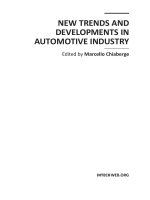New Trends and Developments in Automotive System Engineering Part 1 potx
Bạn đang xem bản rút gọn của tài liệu. Xem và tải ngay bản đầy đủ của tài liệu tại đây (1.21 MB, 40 trang )
NEW TRENDS AND
DEVELOPMENTS IN
AUTOMOTIVE
SYSTEM ENGINEERING
Edited by Marcello Chiaberge
New Trends and Developments in Automotive System Engineering
Edited by Marcello Chiaberge
Published by InTech
Janeza Trdine 9, 51000 Rijeka, Croatia
Copyright © 2011 InTech
All chapters are Open Access articles distributed under the Creative Commons
Non Commercial Share Alike Attribution 3.0 license, which permits to copy,
distribute, transmit, and adapt the work in any medium, so long as the original
work is properly cited. After this work has been published by InTech, authors
have the right to republish it, in whole or part, in any publication of which they
are the author, and to make other personal use of the work. Any republication,
referencing or personal use of the work must explicitly identify the original source.
Statements and opinions expressed in the chapters are these of the individual contributors
and not necessarily those of the editors or publisher. No responsibility is accepted
for the accuracy of information contained in the published articles. The publisher
assumes no responsibility for any damage or injury to persons or property arising out
of the use of any materials, instructions, methods or ideas contained in the book.
Publishing Process Manager Iva Lipovic
Technical Editor Teodora Smiljanic
Cover Designer Martina Sirotic
Image Copyright hxdbzxy, 2010. Used under license from Shutterstock.com
First published January, 2011
Printed in India
A free online edition of this book is available at www.intechopen.com
Additional hard copies can be obtained from
New Trends and Developments in Automotive System Engineering,
Edited by Marcello Chiaberge
p. cm.
ISBN 978-953-307-517-4
free online editions of InTech
Books and Journals can be found at
www.intechopen.com
Part 1
Chapter 1
Chapter 2
Chapter 3
Part 2
Chapter 4
Chapter 5
Chapter 6
Chapter 7
Preface XI
Fuel Efficiency and ESU Improvements 1
Experimental Test of a Diesel Engine
using Envo-Diesel as an Alternative Fuel 3
M.A.Kalam and H.H. Masjuki
Analytical Methods for Determining
Automotive Fuel Composition 13
Jonas Gruber, Renata Lippi,
Rosamaria W. C. Li and Adriano R. V. Benvenho
Automotive Fuel Consumption in Brazil:
Applying Static and Dynamic
Systems of Demand Equations 29
Mariana Iootty, Helder Pinto Jr. and Francisco Ebeling
Material Characterization and Improvements 45
Fatigue and Fracture Behavior
of Forging Die Steels 47
Ryuichiro Ebara
Optimization of Injection Moulded
Polymer Automotive Components 65
Ribeiro, C.J. and Viana, J.C.
High Mn TWIP Steels
for Automotive Applications 101
B. C. De Cooman, Kwang-geun Chin and Jinkyung Kim
Powder Injection Moulding
– An Alternative Processing
Method for Automotive Items 129
Berenika Hausnerova
Contents
Contents
VI
Thermomechanical and Isothermal Fatigue Behavior
of Gray Cast Iron for Automotive Brake Discs 147
Omar Maluf, Jéferson Aparecido Moreto, Maurício Angeloni,
Marco Antônio Colósio, José Carlos Santos,
Waldek Wladimir Bose Filho and Dirceu Spinelli
Advanced Robotic Radiative Process Control
for Automotive Coatings 167
Fan Zeng and Beshah Ayalew
New Components and Related Technologies 187
DC/DC Step-Up Converters for Automotive Applications:
a FPGA Based Approach 189
M. Chiaberge, G. Botto and M. De Giuseppe
The Thermo-mechanical Behavior
in Automotive Brake and Clutch Systems 207
Abdullah M. Al-Shabibi
Dynamic Analysis of an Automobile Lower Suspension
Arm Using Experiment and Numerical Technique 231
S. Abdullah, N.A. Kadhim, A.K. Ariffin and M. Hosseini
Increased Cooling Power with Nucleate Boiling
Flow in Automotive Engine Applications 249
Helfried Steiner, Günter Brenn,
Franz Ramstorfer and Bernd Breitschädel
The “Equivalent Cable Bundle Method”:
an Efficient Multiconductor Reduction
Technique to Model Automotive Cable Networks 273
Guillaume Andrieu, Xavier Bunlon, Lamine Koné,
Jean-Philippe Parmantier, Bernard Démoulin and Alain Reineixl
Fatigue Characteristic of Automotive Jounce Bumper 297
Aidy Ali, R.S. Sidhu and M.S.A. Samad
Control Systems and Algorithms 307
On the Control of Automotive
Traction PEM Fuel Cell Systems 309
Ahmed Al-Durra, Stephen Yurkovich and Yann Guezennec
An AdaptiveyTwo-Stage Observer in the Control
of a New ElectromagneticyValve Actuator
for Camless Internal Combustion Engines 343
Paolo Mercorelli
Chapter 8
Chapter 9
Part 3
Chapter 10
Chapter 11
Chapter 12
Chapter 13
Chapter 14
Chapter 15
Part 4
Chapter 16
Chapter 17
Contents
VII
Integrated Controller Design
for Automotive Semi-Active Suspension
Considering Vehicle Behavior with Steering Input 369
Masaki Takahashi, Takashi Kumamaru and Kazuo Yoshida
Design of an Embedded Controller
for Some Applications of an Automotives 383
Preeti Bajaj and Dinesh Padole
Arbitration Schemes for Multiprocessor Shared Bus 395
Preeti Bajaj and Dinesh Padole
Towards Automotive Embedded Systems
with Self-X Properties 411
Gereon Weiss, Marc Zeller and Dirk Eilers
4D Ground Plane Estimation Algorithm
for Advanced Driver Assistance Systems 433
Faisal Mufti, Robert Mahony and Jochen Heinzmann
Infotainment and Navigation Systems 449
The Car Entertainment System 451
Niels Koch
Information and Communication Support
for Automotive Testing and Validation 473
Mathias Johanson
Trends towards Automotive Electronic
Vision Systems for Mitigation
of Accidents in Safety Critical Situations 493
Ciarán Hughes, Ronan O’Malley, Diarmaid O’Cualain,
Martin Glavin and Edward Jones
Advancements in Automotive Antennas 513
Brendan D. Pell, Edin Sulic, Wayne S. T. Rowe,
Kamran Ghorbani and Sabu John
Development Tools 539
Automotive VHDL-AMS Electro-mechanics Simulations 541
Mariagrazia Graziano and Massimo Ruo Roch
Potential and Drawbacks of Raman (Micro)Spectrometry
for the Understanding of Iron and Steel Corrosion 567
Philippe Colomban
Chapter 18
Chapter 19
Chapter 20
Chapter 21
Chapter 22
Part 5
Chapter 23
Chapter 24
Chapter 25
Chapter 26
Part 6
Chapter 27
Chapter 28
Contents
VIII
Computational Techniques
for Automotive Antenna Simulations 585
Faik Bogdanov, Roman Jobava, David Karkashadze,
Paata Tsereteli, Anna Gheonjian, Ekaterina Yavolovskaya,
Detlef Schleicher,Christoph Ullrich and Hicham Tazi
Voltage Stability Analysis of Automotive Power Nets
Based on Modeling and Experimental Results 611
Tom P. Kohler, Rainer Gehring, Joachim Froeschl,
Dominik Buecherl and Hans-Georg Herzog
Vehicle Design 631
Urban and Extra Urban Vehicles:
Re-Thinking the Vehicle Design 633
Andrea Festini, Andrea Tonoli and Enrico Zenerino
Analysis Approach of How University Automotive
Competitions Help Students to Accelerate
Their Automotive Engineer Profile 649
Francisco J. Sánchez-Alejo, Miguel A. Álvarez,
Francisco Aparicio and José M. López
Chapter 29
Chapter 30
Part 7
Chapter 31
Chapter 32
Pref ac e
In the last few years the automobile design process is asked to become more respon-
sible and responsibly related to environmental needs.
Basing the automotive design not only on the appearance, the visual appearance of the
vehicle needs to be thought together and deeply integrated with the “power” devel-
oped by the engine.
So, vehicle design is becoming more and more diff erentiated and the vehicle behavior
does not actually meet one single standard but is following the market trends. The
vehicles are being designed according to detailed specifi cations and the product is
characterized by specifi c customer’s profi le looking for specifi c solutions to their own
problems, which may be diff erent for diff erent customer’s profi le.
In this complex scenario the defi nition of niche product is becoming obsolete and the
automobile market is becoming a sum of many and very diff erent vehicle categories:
micro car, city car, minivan, SUV, roadster.
Also technological needs are changing, and the race to luxury and big comfortable,
high powered sedan is now leaving place to “smart” vehicles designed to look for an
intelligent solution to diff erent mobility problems.
Or at least this is how it should be.
The vehicle of the future, and the vehicle that customers are looking for nowadays, is
designed upon the basic needs, starting the vehicle and subsystems design according
to the main mission of the vehicle itself: carrying people and goods.
Many aspects are “fi ghting” each other in the “design process”, spanning from eco-
nomic/strategic needs (maintenance costs, taxes used to depend on engine displace-
ment and/or insurance on power, parking areas, driving licenses, etc.) to emerging
standards (The Corporate Average Fuel Economy CAFÉ, new rating method NCAP,
EUROxx regulations, etc.) ending with more technological mission/comfort needs:
• Ergonomic needs
• Small vehicles for urban environment, to reduce traffi c jams
• Fuel effi ciency and pollution reduction
o Lightweight
XII
Preface
o Alternative fuels
o Vehicle usage optimization
o Engine Downsizing
• Safety
• Performance
• Off ering to the customer the capability of changing the vehicle confi guration (seats,
luggage)
The need of reducing pollution and fuel consumption then indicates technologies like
Stop & start – Micro & mild hybrids, as suitable powertrain layouts, dramatically re-
ducing pollution while in traffi c jams, or allowing the downsizing of the thermal en-
gine, while keeping the performance at an acceptable level.
All these considerations lead to the conclusion that the optimization of the vehicle can
be done only by optimizing the entire system, not looking for the optimum solution in
each single subsystem.
The purpose of this book is therefore to try to present the new technologies develop-
ment scenario, and not to give any indication about the direction that should be given
to the research in this complex and multi-disciplinary challenging fi eld.
Marcello Chiaberge
Mechatronics Laboratory – Politecnico di Torino
Italy
Part 1
Fuel Efficiency and ESU Improvements









